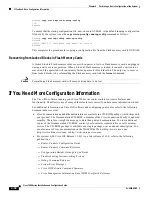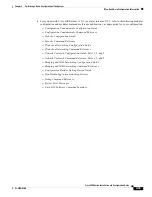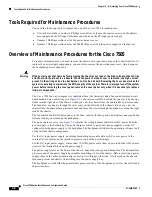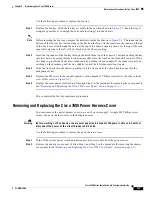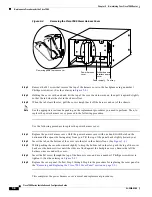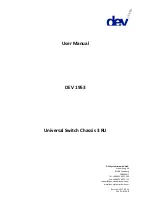
4-28
Cisco 7500 Series Installation and Configuration Guide
OL-5008-03 B0
Chapter 4 Performing a Basic Configuration of the System
Using the Flash Memory Cards in the RSPs
•
You know the filename of the image you want to copy into the Flash memory card.
Following is the procedure for copying a bootable file (called new.image) into the Flash memory card:
Step 1
Boot the router and allow it to initialize.
Note
If you have already formatted a Flash memory card, you can use it instead; however, with an RSP4, you
cannot boot from or use a Flash memory card formatted on another type of system (including the
RSP7000, RSP1, and RSP2). You must reformat the Flash memory used on one of these systems before
you can use it as a boot or storage source with the RSP4.
Caution
To prevent system problems, use Flash memory cards in the RSP4 that were formatted on an RSP4, or
an RSP1, RSP2, or RSP7000 running Cisco IOS Release 11.1(8) or a later release of 11.1 CA.
Formatting a Flash memory card will cause existing data to be lost.
Step 2
Enable the router by copying the image new.image to the Flash memory card, making this image in the
Flash memory card (in slot 0) the default boot image, and rebooting the router, using the following series
of commands:
Router> en
Password:
Router# copy tftp:new.image slot0:new.image
20575008 bytes available on device slot0, proceed? [confirm]
Address or name of remote host [1.1.1.1]?
Loading new.image from 1.1.1.1 (via Ethernet1/0): !!!
!!!!!!!!!!!!!!!!!!!!!!!!!!!!!!!!!!!!!!!!!!!!!!!!!!!!!
!!!!!!!!!!!!!!!!!!!!!!!!!!!!!!!!!!!!!!!!!!!!!!!!!!!!!
[OK - 7799951/15599616 bytes] CCCCCCCCCCCCCCCCCCCCCCCC
CCCCCCCCCCCCCCCCCCCCCCCCCCCCCCCCCCCCCCCCCCCCCCCCCCCCCC
CCCCCCCCCCCCCCCCCCCCCCCCCCCCCCCCCCCCCCCCCCCCCCCCCCCCCC
CCCCCCCCCCCCCCCCCCCCCCCCCCCCCCCCCCCCCCCCCCCCCCCCCCCCCC
Router#
In the preceding example, the exclamation points (!!!) appear as the file is downloaded, and the “C”
characters signify calculation of the cyclic redundancy check (CRC) value, which is a verification that
the file has been correctly downloaded to the Flash memory card.
This completes the procedure for copying a bootable image into a Flash memory card.
Copying Bootable Images Between Flash Memory Cards
As future releases of Cisco IOS images become available, you will receive these images either as a file
booted from a network server, a file on a floppy disk, or a file on a Flash memory card.
The following scenario describes how to use a newly released image on a Flash memory card in a system
that has an older image on a Flash memory card in slot 0 and a default boot image in the onboard Flash
memory.
For this scenario, the filenames are as follows:
•
The new image on the new Flash memory card is image.new.
•
The old image in the Flash memory card in slot 0 is image.old.



















